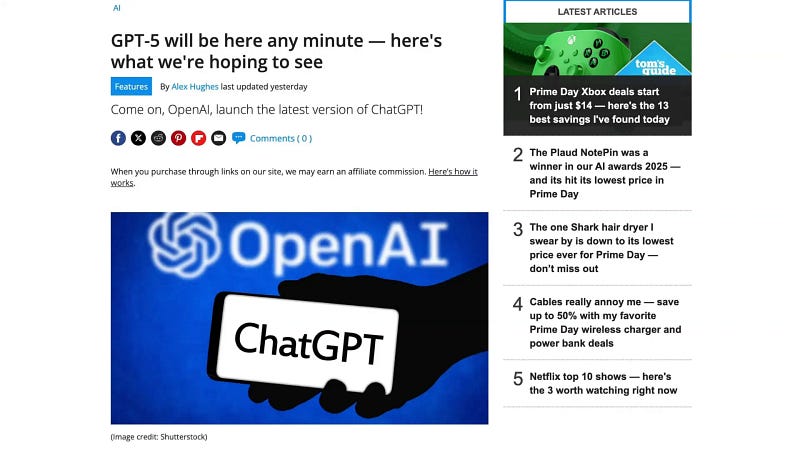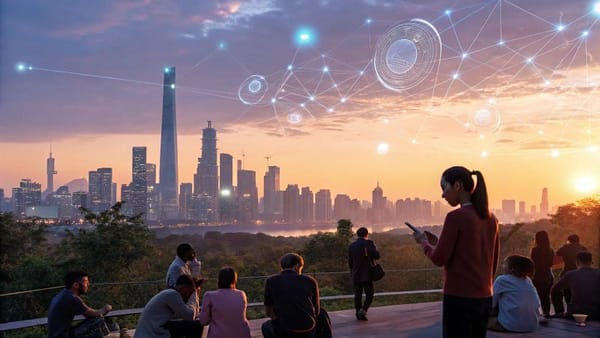Everything We Know About GPT-5 So Far: Exploring the Latest AI Trends
As enthusiasts and professionals in the AI space, we are always eager to explore the next major breakthrough in artificial intelligence…

As enthusiasts and professionals in the AI space, we are always eager to explore the next major breakthrough in artificial intelligence. One of the most anticipated developments is OpenAI’s GPT-5, a model rumored to be just around the corner and poised to significantly impact AI trends across industries. In this article, we dive into everything we know about GPT-5 so far — its expected features, potential impact, and the excitement building around its release.
Drawing on insights from industry experts and recent rumors, we’ll unpack how GPT-5 aims to unify OpenAI’s technology and what that means for users, developers, and the broader AI ecosystem.
Table of Contents
- The Journey to GPT-5: From Orion to Reasoning Models
- Shifting AI Trends: From Scaling Walls to New Methodologies
- GPT-5: The Promise of Unified Intelligence
- GPT-5 as a Systems Integration Milestone
- Signs That GPT-5’s Release is Near
- GPT-5 as an AI Operating System
- What GPT-5 Means for Different Users
- The Competitive Landscape and Industry Stakes
- When Can We Expect GPT-5?
- Conclusion
- Frequently Asked Questions (FAQ)
The Journey to GPT-5: From Orion to Reasoning Models
GPT-5 has been “coming soon” for nearly a year, but the model we expect to see will be markedly different from initial rumors. Back in mid-2023, whispers circulated about OpenAI’s next big model, codenamed Orion, with hopes for a release as early as December. However, the industry faced challenges, including a growing narrative that pretraining — a foundational method for training large language models — had hit a wall.
Instead of a straightforward upgrade through GPT-3, 3.5, and 4, OpenAI pivoted to launching their first reasoning models: O1 and O3. These reasoning models proved to be a turning point, catalyzing new use cases, boosting enterprise adoption, and ushering in the era of agentics, where AI agents use tools to perform complex tasks.
Around this time, GPT-4.5 was introduced, but it didn’t deliver a substantial leap in capability. It found a niche audience seeking improved writing assistance but failed to capture broad public attention and is now being phased out from the API.
As Swyx from Latent Space observed, “the ‘failure’ of GPT-4.5 relative to O3 and O4 Mini is actually fantastic validation of the bet on the reasoning paradigm.” This means that smaller, reasoning-enabled models outperformed larger parameter models on critical open-domain tasks.
Shifting AI Trends: From Scaling Walls to New Methodologies
Last fall, many in the AI community questioned whether scaling model size further was worthwhile, suggesting that new methodologies like test-time compute, reasoning, and agentics would drive the next improvements.
Fast forward six to nine months, and optimism has surged. Logan Kilpatrick, head of product at Google AI Studio, recently remarked that the coming six months in AI will be the “most wild” we have seen so far, with scaling, hardware, product knowledge, and market fit all accelerating.
GPT-5: The Promise of Unified Intelligence
The core excitement around GPT-5 centers on its promise to unify OpenAI’s technology. Romaine Hewitt, OpenAI’s head of developer experience, shared that GPT-5 will merge the reasoning breakthroughs from the O series with the multimodality advances of the GPT series into one cohesive model.
This unification means GPT-5 will eliminate the need for users to switch between different models for different tasks. As OpenAI VP Jerry Torek stated in a Reddit AMA, GPT-5 is “our next foundation model that is meant to just make everything our models can currently do better and with less model switching.”
Moreover, GPT-5 is expected to integrate more tightly with agentic tools, making it more useful across a broader range of tasks.
Sam Altman echoed similar sentiments earlier in the year, expressing a desire to “return to magic unified intelligence” and to simplify the complex array of models and product offerings OpenAI currently maintains.
Key Features and Rumors Surrounding GPT-5
- Context Window: Rumors suggest GPT-5 will support a 256,000-token context window, aligning with many competitors but still short of Google’s million-token context window.
- Multimodality: Native support for video, images, and audio inputs — and possibly outputs — could make GPT-5 more versatile than ever.
- Mixture of Experts Architecture: Inspired by recent advances from Chinese labs, this design activates only parts of the model during inference, enabling billions of parameters with significantly lower operational costs — potentially 60% cheaper per token compared to GPT-4o.
- Improved Memory: Enhancements in memory could enable more effective agent behavior and richer tool integration.
For developers, this means rethinking prompt design to accommodate giant contexts, richer tool calls mixing text with time-based media, and expecting lower latency with cheaper API usage despite the model’s larger size.
GPT-5 as a Systems Integration Milestone
Rather than a simple parameter increase, GPT-5 represents a significant systems integration milestone. Since GPT-4’s release, OpenAI has been continuously adding features like memory and updated image generation. GPT-5 is the first chance to bake these functionalities in natively — training the model from the ground up to optimally use all available tools.
As one commentator put it, GPT-5 might be the first model to truly feel like Artificial General Intelligence (AGI), capable of thinking, planning, acting, and adapting like never before by integrating full reasoning, agentic tool use, chain-of-thought processes, and deep research capabilities.
Signs That GPT-5’s Release is Near
Users have reported extensive A/B testing on the platform, particularly around how reasoning traces are presented. Some interactions suggest “hybrid reasoning,” where the model dynamically decides whether to apply deep reasoning based on the prompt.
For example, a recent user interaction with the GPT-4o model (which isn’t natively reasoning-enabled) included the model saying, “Just a moment. I want to give this one the extra thought it deserves.” This indicates OpenAI may have developed methods to selectively engage reasoning only when necessary.
An interesting new UI feature, a button labeled “Answer Now,” appears to let users cut reasoning short and receive a prompt answer based on the model’s current thought progress. This could solve issues where models get stuck in rabbit holes of reasoning without a way to stop.
GPT-5 as an AI Operating System
Karina Nguyen, an OpenAI researcher, cryptically described GPT-5 as a “super intelligent operating system” rather than just a single model. This aligns with the vision of GPT-5 as a framework or platform that integrates multiple AI capabilities seamlessly.
TJ Ridgeway elaborates, “GPT-5 is the AGI framework… the one ring to rule them all,” highlighting that the roadmap GPT-5 represents is a pathway toward AGI, not AGI itself. Innovations in long-term memory are also a crucial component of this framework.
Notably, Sam Altman mentioned earlier this year that OpenAI is “confident we know how to build AGI as we have traditionally understood it.” GPT-5 might be the closest step yet in that direction.
What GPT-5 Means for Different Users
Despite the excitement, some hardcore AI users might find GPT-5 underwhelming if rumors hold true. Sam Altman reportedly isn’t especially impressed with its performance compared to existing reasoning models like O1 or Deep Research. GPT-5 may be more of an iterative improvement with better benchmarks but not a dramatic capability leap.
However, for the vast majority of users — those who mainly use GPT-4o or aren’t aware of the reasoning models — GPT-5 will feel like a quantum leap. It will provide a unified experience where the model automatically applies the right level of inference and reasoning, delivering better answers without requiring users to understand the underlying model distinctions.
This is particularly important given that most ChatGPT users are not subscribers and have limited exposure to advanced reasoning models. Removing the model selector and making all features available by default will broaden accessibility and delight everyday users, much like the viral “Deep Seek” reasoning demo earlier this year.
The Competitive Landscape and Industry Stakes
The AI race is heating up. Mark Zuckerberg’s recent talent poaching spree has intensified competition, with Meta assembling a “superintelligence” team including experts from OpenAI, Google, and Apple. While Zuckerberg’s public AI ambitions — like automated advertising and AI friends on social media — may seem modest, his assembled team signals a much larger strategic play.
Sam Altman remains confident, emphasizing OpenAI’s talented team and their passion. Still, OpenAI’s leadership is feeling the pressure, as seen in compensation adjustments and internal memos describing the situation as akin to a “house being broken into.”
Given this environment, the GPT-5 release will be a significant moment, not just technologically but as a marker of OpenAI’s position in the evolving AI industry.
When Can We Expect GPT-5?
OpenAI has hinted that something big is imminent, with insiders suggesting a release in the next week or two. However, the company is mindful of the stakes and unlikely to launch anything less than extremely impressive.
Sam Altman’s April announcement indicated a plan to release O3 and O4 Mini before GPT-5, aiming to make GPT-5 “much better than originally thought” and ensuring capacity to handle unprecedented demand.
While the exact release date remains uncertain, the growing chorus of credible rumors suggests an exciting midsummer arrival may be on the horizon.
Conclusion
GPT-5 is shaping up to be a milestone in AI trends, unifying OpenAI’s reasoning, multimodal, and agentic capabilities into a single powerful model. While it may not deliver a dramatic leap in raw capability for hardcore users, its seamless integration and improved accessibility promise to transform the experience for the vast majority of users.
As the AI industry intensifies competition and innovation accelerates, GPT-5 will not only symbolize OpenAI’s technological progress but also its strategic response to mounting pressures. Whether it becomes the “magic unified intelligence” that many hope for remains to be seen, but the excitement around GPT-5 is undeniable.
Frequently Asked Questions (FAQ)
What is GPT-5 expected to bring that previous models did not?
GPT-5 is expected to unify OpenAI’s reasoning and multimodal models into a single system, eliminating the need for model switching and integrating advanced agentic tool use. It will support longer context windows, multimodal inputs like video and audio, and operate more efficiently through a mixture of experts architecture.
Will GPT-5 be a major leap in AI capability?
While GPT-5 will show improvements and better benchmarks, it is likely more of an iterative systems integration milestone rather than a massive qualitative leap, especially for advanced AI users.
How will GPT-5 affect everyday users?
For most users, GPT-5 will feel like a quantum leap by automatically applying the right reasoning and inference without users needing to select or understand different models. This will broaden access to advanced AI features and improve overall user experience.
When is GPT-5 expected to be released?
Rumors and insider hints suggest GPT-5 could be released in the coming weeks, possibly midsummer, but OpenAI is likely to wait until it meets high standards for performance and scalability.
How does GPT-5 fit into current AI industry trends?
GPT-5 exemplifies the trend toward unifying AI capabilities into more efficient, versatile systems, reflecting broader industry momentum in scaling hardware, enhancing model performance, and integrating AI more deeply into products and workflows.
This article is based on comprehensive research derived in part from the referenced video Everything We Know About GPT-5 So Far




